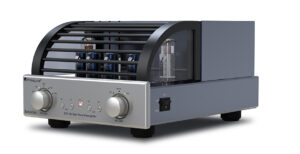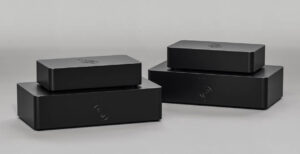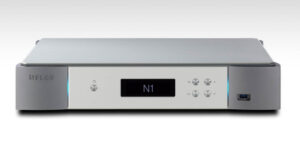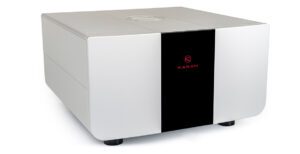
Even before Melco introduced the S100 network switch, hardcore streaming enthusiasts were aware that this oft overlooked part of a streaming network was important. This is evidenced by audio companies making linear power supplies for Netgear and other brands of IT switches, but these were fairly affordable upgrades, the Melco raised the bar quite considerably and I for one was sceptical. Having tried four audiophile switches since that time I am now convinced that the potential of any streaming system is quite significantly hampered by IT switches, even when they have a decent power supply.
Ordinarily the job of a network switch is to route signals around a network as quickly as possible, which doesn’t pose too many challenges for cheap peripheral models, the difficulty arises when you want to do this without letting any interference through with the signal. I was speaking to amplifier designer Tim Narramore (Moor Amps) recently who is of the opinion that the only real problem with digital systems occurs when digital distortions leak through into the analogue signal where their presence is audible even in the smallest quantities. And there is always a degree of this cross contamination in DACs so the best digital systems will be those that have the least amount of noise or interference floating around and the network switch can be a source of this noise if it’s not designed for audio.

Melco is a subsidiary of Japanese storage and network company Buffalo, it makes a range of audiophile NAS drives or ‘music libraries’ as they prefer to call them. There are some clear advantages to being part of a large organisation that specialises in this area not least in terms of expertise. And this is what the company brought to bear on the S100 data switch as they call it, which has eight RJ45 ethernet ports arranged in two blocks of four. One set are 100Mb ports for the low speed traffic produced by audio components, this is where you connect the music server/library and streamer unless you have a Melco or Innuos for instance which have dedicated outputs for the streamer. The other ports are gigabit capable and good for PC and router connections as well as Roon Cores which generate high traffic flow, with an Innuos server (with onboard core) it would seem logical to hook up its LAN port to a gigabit socket on the switch and take its ‘player’ output direct to the streamer.
There are two SFP ports on the S100, these are for the few streaming components that have this optical connection, however Melco’s UK’s distributor, ADMM, will shortly be introducing an SFP audio-over-fibre kit under the new ADOT (Audiophile Digital Optical Technology) brand, which converts ethernet to optical. Melco doesn’t say a lot about what’s going on inside the S100 save that it has a large 1.5MB buffer to the ensure stability and resilience of the data stream and that it uses audiophile techniques in the power supply and high quality capacitors to keep noise down. The first stage of the power supply is switched mode and sits in the power lead providing 12V, the distributor, ADMM, offers a linear power supply by PLiXiR as a £500 upgrade.
It’s worth mentioning the casework on the S100 which is the same as Melco uses on its N100 EX Series music libraries; it oozes Japanese build quality and finish. Internally it has a steel chassis for screening, externally it’s anodised aluminium with a blue LED indicator. There’s no power switch as you rarely need to turn off a network switch.
Initial impressions of the S100 were based on a contrast with a Netgear GS108 powered by a Longdog Audio linear power supply, a rather more affordable package that made the newcomer sound very sumptuous indeed. The obvious benefits were better timing, a much stronger sense of body to the sound and a significant reduction in coarseness through the mid and treble. It made the Netgear sound flat and hard by opening up the soundstage and putting space between the instruments and voice on Michael Chapman’s Rainmaker [Harvest] and making it sound like a much better production than was previously apparent. It also made me wonder why this man’s earlier work is not better known.
With Keith Jarrett’s Budapest Concert [ECM] the piano notes are remarkably clean bright and shiny, as if a veil of grunge has been removed so that the purity of the recording can come through. This also means that the quieter sounds like audience coughs are apparent and that the solidity of the piano, its presence in the listening room is that much more palpable. More important perhaps is that the melodies he plays are that much easier to appreciate, the reduction in noise lets you hear the nuances of playing clearly and you feel a stronger connection with the player. In truth this switch will be a revelation if you are still using a IT peripheral like the Netgear.

With a Cisco 2960 which is a well regarded IT switch in audio circles and using files from Qobuz rather than local ones as above, the results were similar to the earlier showdown. Here the Melco opened up the sound allowing the highs to sparkle and the imaging to solidify, and the hard edged nature to ‘digital’ sound was largely eliminated to let the music flow in a highly natural, vinyl like fashion. The Cisco times well but the S100 bettered it in this department by introducing greater rhythmic sophistication. I stuck on what has become a bit of a bass reference track in Bob Marley and the Wailers’ ‘Natural Mystic’ (Natural Mystic (The Legend Lives On), [Island} and was impressed with just how gorgeous the bass is on this recording and just how much shape, depth and texture it can offer up when the system allows it.
Up against the current crop of high end network switch competition things are much more closely fought and the differences become nuanced, however the Melco’s inherent musicality helps it to shine even in pricier company. I particularly like the way that melodies, grooves and rhythms are so well delivered. It achieves this by giving the impression that there’s all the time in the world to present the notes in the correct order and at precisely the right time. Devices that time well are often described as fast but while the S100 could never be called slow, it has a sense of effortless coherence that makes a very strong case for its approach. It allows the drive and power of William Tyler’s ‘Fail Safe’ [Goes West, Merge] to come through in full effect but without any sense of grain or digitality about it. The syncopation that the Grateful Dead achieved is delivered superbly, the relatively rough nature of the recording on Europe ’72 [Warner Bros] is evident but in no way emphasised as is often the case with a recording that captures the band at their finest tight but loose selves. Once they get rolling with the Melco feeding an Auralic Aries G2.1 streamer and Métronome Le DAC converter you just have to go with the flow, there is no inclination to do anything else.
This Melco really does bring many of the qualities of good analogue replay to digital streaming. It doesn’t turn your music files into the sonic equivalent of vinyl but gets pretty damn close if the rest of the components are up to the job. There are a number of albums that I failed to discover before the vinyl revival caused prices to skyrocket, Europe ’72 among them, but this switch goes a long way to making up for this unfortunate side effect of an otherwise good thing.
One quality that I look for in audio components is a sense of calm, it’s an indication that all forms of noise are being kept at bay and that means there is less distortion being added to the music signal. The S100 is very calm, managing to sound more relaxed and effortless than everything I compared it with, the difference wasn’t huge and some systems will make more of it than others, but it was clear enough. It’s worth mentioning that a switch upgrade like many others will be more obvious in a high resolution system. There are many who will think it’s mad to spend so much on something that isn’t necessarily in the signal path, and that such things can’t have any real bearing on the result. But in a revealing system the benefits of a barrier to electrical noise are easy to hear and even easier to enjoy, so much so that I may have to start negotiating with Melco so that I can keep the S100, it’s going to be a difficult transition back to real world data switches.
TECHNICAL SPECIFICATIONS
- Type: Streaming audio network switch
- LAN Ethernet ports: four 100Mb, four 1GB (via RJ45)
- Fibre optic ports: two (via SFP)
- Clock: not specified
- Packet data buffer: 1.5MB
- Features: external SMPS with upgrade option
- Finish: Silver/black
- Dimensions (H×W×D): 61 × 215 × 269mm
- Weight: 2.5kg
- Price: £2,099
Manufacurer: Melco Syncrets Inc.
UK Distributor: ADMM
Tel: +44(0)1252 784525
By Jason Kennedy
More articles from this authorRead Next From Review
See all
PrimaLuna EVO 100 phono preamplifier
- Apr 22, 2024

Reiki Audio SuperSwitch Master Pro + Servant Pro
- Mar 27, 2024

Melco Audio N1-S38 music server
- Mar 27, 2024











